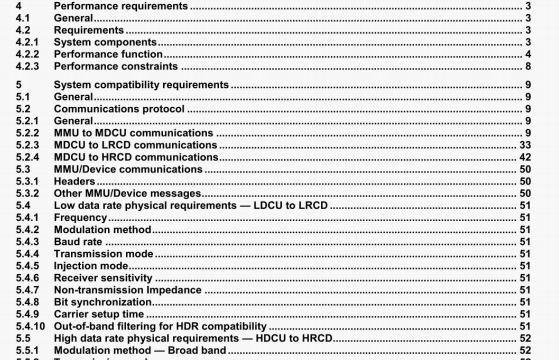ISO 10368 pdf download – Freight thermal containers一Remote condition monitoring.
The fields in Figure 6 are defined as follows:
Alpha network address — This is compnse of 4-byte ASCII characters defining an RCD alpha portion
(usually denoting the container operator) of the RCD network address on the power lane network. All
RCDs recognize the map command by using the universal address, or four ASCII Os, or 30H. 30H. 30*1.
30*1.
Type repeat — This is a 3-byte check field filled with a map command (045H), The deve map command value is used instead of the RCD map command to allow an alphanumeric value to reside in the normally numeric polling field,
— Map subcommand — This as a I -byte ASCII character which provides an RCO with a processing procedure in the mapping strategy. These procedures, and hew associated values, are given below.
Unused HRCD destination address — This is a 2-byte hexadecimal field which provides an HRCD with a network address. Only the HRCD(s) responding to the map command use this address. This field is used only when the alpha network address specifies the universal address, i.e. four ASCII Os. or 30H, 30H, 3011. 30H
— Destmahon address individual — This is a 2-byte hexadecimal field which provides an HRCD with a network address. Only the HRCD responding to the map command uses this address. This field is present only when the map address specifies an individual 11-byte address.
Shift variable — This is the upper nibble of the byte and shall be 1111 B, The lower nibble contains a number from 0 to 15 which indicates the number of bits to mask from an RCO’s 16-bit random number (0 will provide a 1111111111111111 B bit mask, while 15 will provide 0000000000000001 B). An RCO which obtains a value of zero by performing the logical AND of this mask with the 16-bit random number will attempt to return its network address provided that its internal respond to map flag is set (see below). Thus, this shift variable provides the mapping strategy with the capabilities of adjusting the range, or size. of the expected number of RCD responding.
Any field described above which does not contain a value as required wil ignore the command. Thus, the data field sent to the MDCU from the MMU is:
Data field to MDCU Network address tag/map infoa’mation
An RCD will not accept a map command unless the alpha network address characters match those of the particular RCD or the universal address. This provides for selection of different dasses of RCDs using the sanie data rate and thus the same routing byte. When accepted, the RCO decodes the map subcommand to perform different strategies of the mapping sequence. These subcommands are listed in Table 6. Any other value received by the RCD in the subcommand will force the RCD to ignore the command. Each RCD addressed will perform the map function received regardless of the respond to map state, Only after execution of the map function does the RCD check the respond to map state. If a map response is indicated, the RCD performs the logical AND of the shift variable mask with its 16-bit random number A value of zero will allow the RCD to return its network address.
The time between the xmit and interactive poll is the responsibility of the MMU, and shall be enough to allow the RCD to process and buffer its response. If an RCD response buffer does not contain information, a negative acknowledge (see 52.22.35) is returned from the RCD to the MDCU. and consequently to the MMU. If, however, the RCD has buffered information, this information is returned to the MMU via a general valid type reply (see 5.2.2.3.2) with this information preceded in the data field by the network tag and the RCD’s address,
Data field from MDCU valid Routing byte/address • RCD message
Once the RCD transfers this buffered data, It resets (and thus empties) its RCD response buffer, thereby allowrng another RCD xmit or interactive command to be accepted by the RCD
5.2.2.2.3.7 DevIc, poll command
The deve pol1 command requests the quick status buffer of the controller wti.ch is attached to the selected iRCD or the internal quick status of the sRCD. The data field sent to the MDCU from the MMU contains the routing byte followed by the 11-byte ASCII RCD network address and the expected reply length. i.e.:
Data field to MDCU = Routing byte/address
A valid reply from the MDCU contains the routing byte/address and the controller (IRCD) or Internal (5RCD) quick status buffer In the data field of a general valid type reply (see 5.2.2.3.2). I.e.:
Data field to MDCLJ valid = Routing byte/address • Quick status
For an IRCD, an image of the controller quick status buffer is contained within the ,RCD and updated approximately every 30 s. For both the IRCD and the sRCO. the reply format of the data field of this message is presented in Figure 7.
ISO 10368 pdf download – Freight thermal containers一Remote condition monitoring
